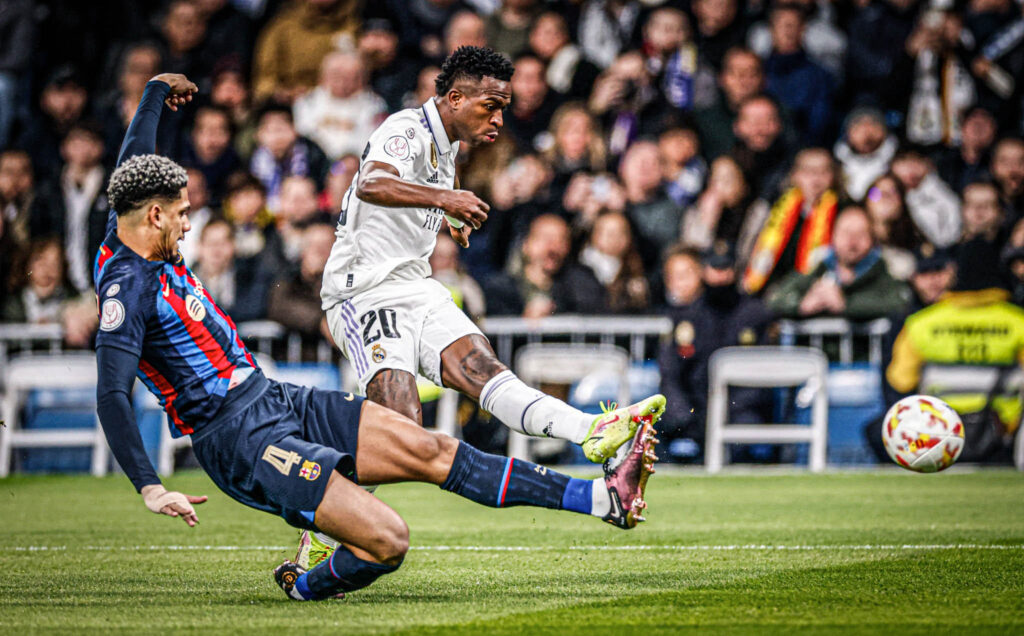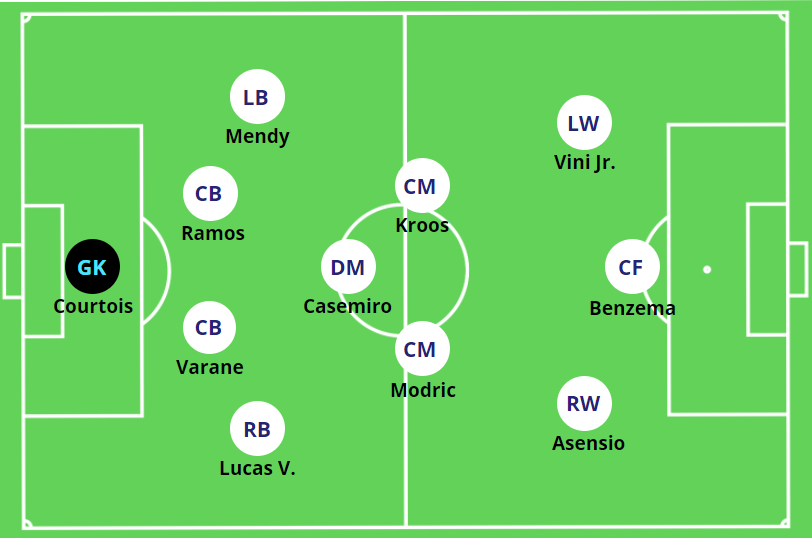
Discover Real Madrid’s Style of Football in our Comprehensive Guide! Delve into the tactics, techniques, and flair that define Real Madrid’s gameplay. Get ready for an in-depth analysis of one of the world’s most iconic football clubs.
The Legacy of Real Madrid Football Style
Since their inception, Real Madrid has been synonymous with a style of football that is both dominating and entertaining. This strong and powerful approach has become a cornerstone of their enduring legacy.
The ‘Galacticos’ policy – a term coined in the early 2000s – is a significant part of how the club structures their game. This high-stakes strategy involves buying world-class, often celebrity footballers, to ensure a star-studded line-up that is as mesmerizing off the field as it is on it.
This policy isn’t just about drawing crowds; it’s about maintaining a level of football that commands respect and awe from opponents.
On the field, Real Madrid’s style can be categorized as dynamic and flexible. The team is not rigidly linked to a single formation but adapts based on the opposition and game context. This dynamism approach helps them stay unpredictable and always a step ahead.
The Real Madrid style is like a chameleon, changing colors according to the environment but always maintaining its essence. – Anonymous
Real Madrid’s football style is also characterized by an aggressive, high-pressing defensive stance. They aim to regain possession quickly and launch into fast, lethal counter-attacks. This combination of a high-octane offense and a no-nonsense defense has been a significant factor in their numerous victories.
Real Madrid’s Formation and Tactics Explained
Real Madrid has not just mastered, but also revolutionized, the art of football. But what is it that makes them so distinctive?
The answer lies in their formation and tactics.

Real Madrid is synonymous with the 4-3-3 formation, a strategic move that has been instrumental in their numerous victories. This formation comprises four defenders, three midfielders, and three forwards. But, like a well-conducted symphony, it isn’t just about the numbers.
- Defence: The four defenders act as a cohesive unit, focusing on both man-marking and zonal strategies. This balance between personal responsibility and teamwork is what makes Madrid’s defence formidable.
- Midfield: The trio of midfielders are the team’s engine. With a holding midfielder acting as the defensive pivot, the other two primarily focus on orchestrating the game, distributing the ball, and providing key passes.
- Attack: The three forwards are known for their fast-paced attacking play. Their roles are fluid, often interchanging positions, keeping the opposition’s defence guessing and creating numerous goal-scoring opportunities.
However, tactics are not set in stone and Real Madrid is famous for their adaptability. Depending on the opponent, the team may switch to a 4-4-2 or even a 4-2-3-1 formation. Flexibility is key, and it’s this unpredictable nature that keeps rival teams on their toes.
Real Madrid’s tactics also involve dominance in set-pieces. Both from an offensive and defensive perspective, Madrid’s height advantage combined with their strategic plays often results in scoring or preventing crucial goals.
But let’s not forget – the beauty of Real Madrid’s game lies in their counter-attacks. They are known for their lightning-quick transitions from defence to attack, catching their opponents off guard and turning the tables in a matter of seconds.
The Role of Key Players in Real Madrid Style of Play
Real Madrid’s style of football is a beautiful symphony, with each player playing a vital part in harmonizing the team’s overall performance.
The key players, much like the lead musicians in an orchestra, carry significant responsibility in dictating the rhythm and flow of the game.
Vinicius Jr. is known for his incredible speed, dribbling skills, and ability to take on defenders one-on-one. He is also a versatile player who can play on either wing or as a forward.
Cristiano Ronaldo, during his tenure, was a prime example of such an influential figure. His lethal attacking prowess and unmatched scoring ability were core elements of Real Madrid’s offensive strategy.
Luka Modric and Toni Kroos, two midfield maestros, orchestrate the tempo of the game like virtuoso conductors. Their vision and passing skills enable them to control the midfield and distribute the ball with precision, often setting up goal-scoring opportunities.
Real Madrid’s style of football also heavily relies on their defensive stalwarts. Sergio Ramos and Raphael Varane were the backbone of the defense, with their strength, tactical acumen, and ability to read the game.
Finally, let’s not forget the pivotal role of the goalkeeper. Thibaut Courtois has been instrumental in safeguarding Real Madrid’s goal with his outstanding shot-stopping and commanding presence in the penalty area.
These key players, with their unique skills and roles, have shaped the distinctive style of football Real Madrid is renowned for. The fluidity and dynamism orchestrated by these maestros make Real Madrid a force to be reckoned with in the world of football.
The Importance of Ball Possession in Real Madrid Football Style
When you talk about Real Madrid, one thing that instinctively comes to mind is their emphasis on ball possession. This aspect of their game is as iconic as their white jerseys, and integral to their style of football. Let’s dive a little deeper into why it’s so important.
Control the Tempo: One of the key advantages of maintaining high ball possession is that it allows Real Madrid to control the tempo of the game. In essence, they dictate the pace and rhythm, forcing the opposition to play at their beat.
Pressure and Exhaustion: By holding onto the ball, Real Madrid applies constant pressure on the opposition, often leading to mental and physical exhaustion. It’s a strategy to wear down opponents over the course of the 90 minutes.
“To have the ball is to control the game.” – Xabi Alonso, Former Real Madrid Midfielder
Creating Scoring Opportunities: Perhaps, the most crucial reason for their ball possession is to create scoring chances. With talented players like Karim Benzema and Vinicius Junior, Real Madrid can swiftly turn possession into potential goals.
But it’s not just about having the ball. It’s about what you do with it. And that’s where Real Madrid’s intricate passing game comes into play.
The Art of Counter-Attacking: Real Madrid Speciality
Mastering the art of counter-attacking is no small feat, but it’s one that Real Madrid has most certainly achieved. It’s not just about speed and force, but also about intelligence and coordination.
Real Madrid’s counter-attacks demonstrate a perfect blend of rapid transition, quick decision-making, and precision passing. The players, like knights in a chess board, know exactly when to move and how to exploit the opponent’s vulnerabilities.
- Speed: The moment the ball is won, a whirlwind of white shirts hurtles towards the opposing goal. The tempo is swift, catching the opposition off guard.
- Transition: The switch from defense to offense is almost instantaneous. Players intuitively know where to position themselves for maximum impact.
- Passing: The accuracy and speed of the passes during a counter-attack are crucial. Real Madrid’s players exhibit a seamless synergy, weaving the ball between them like a well-choreographed dance.
“It’s like watching a predator stalking its prey. Patient and strategic until the moment they pounce, then it’s all speed and power,” says a die-hard Madrid fan.
Let’s delve deeper and break down the stages of a typical Real Madrid counter-attack.
Stage One: Winning the Ball
It all starts with robust defense. Madrid’s players are tenacious in retrieving the ball, often doubling up to increase their chances. The moment possession is won, the counter-attack comes into play.
Stage Two: Rapid Transition
The transition from defense to attack is rapid, like a leopard pouncing. Players move swiftly, occupying space and catching the opposition off balance.
Stage Three: Precision Passing
Once in control, the team keeps the ball moving quickly with accurate passes. They cut through the opposition like a hot knife through butter, rendering them almost helpless.
Stage Four: The Final Strike
The climax of the counter-attack is a shot on goal. After a swift, strategic build-up, the strike is usually potent and clinical. It’s a spectacle that leaves fans and opponents in awe.
Indeed, Real Madrid’s style of football is a beautiful yet deadly dance, where every step is calculated and every move is lethal. The counter-attack isn’t just a tactic; it’s an art form, perfectly mastered by the men in white. The Defensive Strategy of Real Madrid’s Football Style
Real Madrid High-Pressing Game: How it Works
Real Madrid’s high-pressing game is akin to a well-choreographed dance, where each player perfectly understands his role and executes it with precision. It’s a strategy that demands a high level of fitness, tactical understanding, and unflinching discipline from the players.
The Basics of High-Pressing
At its core, high-pressing involves applying pressure on the opposing team in their half of the pitch. This strategy is designed to force errors from the opposition, providing Madrid with opportunities to reclaim possession and launch attacking moves.
High-pressing is not just about running aimlessly; it’s a tactical masterpiece.
Key Elements of Madrid’s High-Pressing Game
- Density in Opposition Half: Madrid players swarm the opposition half, especially around the ball, making it difficult for opponents to build their play.
- Rapid Transition: One of the hallmarks of Madrid’s style is the rapid transition from defense to attack once the ball is won.
- Coordinated Pressing: It’s not a one-man show. The team moves and presses as a unit, making it a coordinated effort.
It’s a strategy that requires a lot from the players, but when executed correctly, it’s a sight to behold. La Casa Blanca has certainly mastered this high-octane style of play.
But how do they do it? Let’s break it down.
How Madrid Executes High-Pressing
| Phase | Action |
|---|---|
| Reclaiming Possession | Players close down spaces, forcing the opposition into errors or long balls. |
| Transition | Once possession is won, the ball is quickly moved forward to exploit open spaces in the opposition defense. |
| Attack | The team then attacks swiftly, often targeting the area where ball possession was won. |
It’s a high-risk, high-reward strategy, but one that has brought immense success to Real Madrid. So, the next time you’re watching a Madrid game, keep an eye out for their high-pressing tactics. It’s not just entertaining, it’s football at its tactical best.
Read Also: From Dream to Reality: How to Meet Manchester United Players and Pose for Epic Photos
The Philosophy Behind Real Madrid Style of Football
At the heart of Real Madrid’s football style, there’s a philosophy that’s both simple and complex. It’s all about domination – a beautiful blend of possession, aggression, and precision. A combination that’s led to their astounding success over the years.
Galácticos, a term often associated with the club, encapsulates their high-profile playing style. It’s a strategy that involves the signing of world-class, oftentimes high-profile, players who bring both skill and star power to the pitch. This philosophy isn’t just about creating a powerful team, it’s about creating a spectacle.
Stylistically, Real Madrid employs a ‘direct attacking’ approach. It’s a fast-paced, forward-moving playing style that leverages the team’s technical skills to maintain possession and control over the game. When the team has the ball, they’re like a well-oiled machine, each gear moving in sync with the next.
Crucial Elements of Real Madrid’s Style
- Possession: Real Madrid’s playstyle is characterized by their calculated possession of the ball. It’s not just about having the ball, but what they do with it.
- Aggression: They play aggressively, but not recklessly. Their aggression is calculated, intended to apply pressure and seize control.
- Precision: Precision in passing and movement is key. Each pass, each move is calculated to bring them closer to the goal.
Real Madrid’s style of play is, in essence, a chess match – a strategic, calculated game where each move is made with purpose. It’s a style that’s brought them immense success and a legion of fiercely loyal fans.
Historical Achievements of Real Madrid Style of Play
Their illustrious history is laden with numerous titles, but their dominance in Europe’s premier competition, the European Cup/Champions League, stands out.
European Dominance:
Real Madrid won the very first edition of the European Cup in 1956 and then went on to clinch the title for the next four consecutive years, a feat that remains unmatched.Their dominion in this competition is unparalleled, with 14 titles to their name as of 2022, making them the most successful club in the history of the Champions League.
Iconic Matches
Real Madrid’s journey has been punctuated with matches that have not just added to their trophy cabinet but have also defined their style and ethos. Here are some of the standout fixtures:
Real Madrid vs Eintracht Frankfurt, 1960 European Cup Final: This match is often hailed as one of the greatest displays in a European final. Real Madrid trounced Frankfurt 7-3, with the legendary Alfredo Di Stéfano scoring a hat-trick. The match showcased Madrid’s attacking flair and is still remembered as a testament to their European dominance.
Real Madrid vs Juventus, 1998 Champions League Final: After a 32-year wait, Real Madrid secured their seventh European Cup title with a 1-0 victory over Juventus. Predrag Mijatović’s goal ensured victory, marking the beginning of another era of European dominance.
Real Madrid vs Bayer Leverkusen, 2002 Champions League Final: As you mentioned, Zinedine Zidane’s iconic left-footed volley is the standout moment. But the entire match showcased Real Madrid’s resilience and determination to secure their ninth European Cup.
Real Madrid vs Atletico Madrid, 2014 Champions League Final: A fiercely contested derby, the match went into extra time with Real Madrid trailing for most of the game. Sergio Ramos’ last-minute header took the game to extra time, where Madrid scored three more to seal their tenth title, or “La Décima.”
Real Madrid vs Liverpool, 2018 Champions League Final: Apart from the final score of 3-1, the game is remembered for Gareth Bale’s spectacular overhead kick goal, a moment that encapsulated Real Madrid’s flair and penchant for the extraordinary on the biggest stages.
Real Madrid vs Liverpool, 2022 Champions League Final: This was a rematch of the 2018 final, but the stakes were different. Played at the iconic Parc des Princes in Paris on May 28, 2022, the match was a tactical battle between two of Europe’s heavyweights. While Liverpool pressed and created chances, Real Madrid’s defensive organization and clinical finishing made the difference.
Vinicius Junior, the young Brazilian winger, showcased his flair and skill, netting a crucial goal in the second half. But it wasn’t just the outfield players who shone. Thibaut Courtois, Real Madrid’s Belgian shot-stopper, put on a goalkeeping masterclass. With a series of crucial saves, he thwarted Liverpool’s attackers time and again, rightfully earning the man-of-the-match accolade.
These matches, among countless others, not only added silverware but also etched unforgettable moments in the annals of football history, showcasing Real Madrid’s style, ethos, and indomitable spirit.
Real Madrid’s Style Of Play Under Ancelotti
Real Madrid’s style of play under Carlo Ancelotti was characterized by a balanced and pragmatic approach. Ancelotti emphasized a possession-based style of play, with an emphasis on quick and incisive passing to break down opposition defenses.
However, he also recognized the importance of defensive solidity and organization, and often deployed a midfield pivot to provide additional cover for the backline.
Ancelotti’s Real Madrid teams were also known for their ability to counter-attack with devastating speed and precision. With players like Cristiano Ronaldo, Gareth Bale, and Karim Benzema leading the line, Real Madrid had the pace and skill to hit opponents on the break and score goals in a matter of seconds.
This made them a formidable opponent in big games, where they could soak up pressure and then strike on the counter.
Another hallmark of Ancelotti’s Real Madrid was their ability to adapt to different opponents and situations. Whether facing a high-pressing team or a deep-lying defense, Ancelotti would adjust his tactics and personnel accordingly.
This flexibility allowed Real Madrid to win games in a variety of ways, and made them a difficult team to predict and prepare for.
Overall, Real Madrid’s style of play under Ancelotti was a blend of possession, counter-attacking, and tactical flexibility. This approach helped them win the Champions League in 2014, and made them one of the most entertaining and successful teams in Europe during Ancelotti’s tenure.
Real Madrid’s Style Of Play Under Zidane
Real Madrid’s style of play under Zinedine Zidane was characterized by a possession-based approach, with an emphasis on quick, incisive passing and movement off the ball. Zidane’s teams typically played with a high defensive line and look to press the opposition high up the pitch in order to win the ball back quickly.
Zidane’s Real Madrid also place a strong emphasis on attacking down the flanks, with the full-backs often pushing forward to provide width and create overloads in wide areas. This allows the likes of Cristiano Ronaldo and Gareth Bale to cut inside and create chances for themselves and their teammates.
Another hallmark of Zidane’s Real Madrid was their ability to counter-attack with devastating effect. With players like Ronaldo, Bale, and Karim Benzema leading the line, Real Madrid were always a threat on the break, and their speed and clinical finishing make them one of the most dangerous teams in world football.
Defensively, Zidane’s Real Madrid were well-organized and disciplined, with a focus on pressing the opposition and winning the ball back high up the pitch. They also had a strong aerial presence, with Sergio Ramos and Raphael Varane forming a formidable partnership at the heart of the defense.
Overall, Zidane’s Real Madrid play an exciting, attacking brand of football that is both effective and entertaining to watch. With a focus on possession, quick passing, and incisive movement, they are one of the most successful teams in world football, having won numerous domestic and European titles in recent years.
